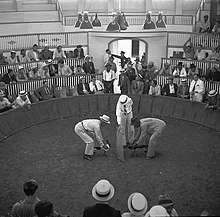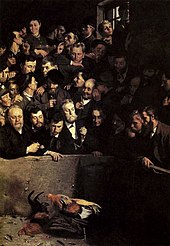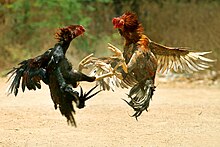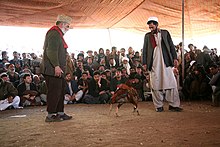Cockfight
A cockfight is a competition in which two roosters are let loose on each other in an arena or on a battlefield. It is based on a rooster’s natural instinct for aggression to assert itself against its conspecifics. A cockfight is usually the outcome of a bet . One of the two roosters is defeated if it no longer fights, is seriously injured or dies. However, the death of one of the roosters is the norm. It is widely believed that cockfighting was the reason the chicken was domesticated. Numerous excavations indicate this. The first written evidence of a cockfight comes from China in 517 BC. At that time, cockfighting was already a royal sport with carefully worked out rules of the game. Even then, the fighting cocks wore artificial metal spurs. At the beginning of the 19th century, cockfighting was a recreational activity that was widespread almost all over the world and was only not pursued in western and southern Africa.
In almost all countries in the western world, cockfighting is prohibited for reasons of animal welfare or because betting bans. Exceptions are some countries in Central and South America and the Philippines . There and despite the ban on the Indonesian island of Bali, for example, cockfighting is still a traditional and popular sport . The highlight of the cockfight is the World Slasher Cup , which takes place in the Araneta Coliseum , Quezon City and where 648 cockfights are held over five days. The stakes are several 100,000 USD in each fight. Due to the long tradition, specific fighter races have emerged, the oldest of which is probably the Asil , which is characterized by tight muscles, an upright posture and a small comb, as well as very aggressive behavior.
history
The history of domestication of the domestic chicken has not yet been conclusively clarified. The domestic chicken, however, is descended from the Southeast Asian Bankiva chicken and one of the earliest cultures to keep chickens was the Indus culture , which spread around 2800–1800 BC. BC along the Indus in the northwest of the Indian subcontinent . There is some indirect evidence that this culture practiced cockfighting: Archaeological finds include a small clay figure holding a cock in a way that is common before cockfighting. An artificial spur and a seal were also found, the representation of which is interpreted as two roosters fighting with each other. In some regions in southern India, cockfighting is still part of religious rituals for worshiping a mother goddess, which may have an origin during this period.
From around 1500 BC, domestic chickens came to Egypt via the Middle East, from where they found their way into the Greek and later Roman cultures. Homer (approx. 800 BC) did not yet mention the domestic fowl, but they are already depicted relatively frequently on black-figure Greek vases; they were probably held mainly for cockfighting. They also served as marks on the shields of the warriors. Domestic chickens have been widely used in Europe since the Romans , who reared chickens on a large scale as egg and meat suppliers. In Julius' Caesars de bello gallico there is talk of taps that are superior to the Roman ones. In England in particular, there is a 2000 year old cockfighting culture that was only banned by law in 1848.
English colonists made cockfights a popular sport in Europe. While fights are now banned in many countries, in Belgium , France , Mexico , the Dominican Republic , Italy , the Philippines , Puerto Rico , Peru , Turkey and Guam there are regular competitions with high stakes in boxing-like arenas.
procedure
The cockfight itself begins when the cocks are put into the arena. In a professional fight there are four people in the arena in addition to the two roosters: one supervisor per rooster as well as a referee and his assistant. In village fights, the supervisor is usually also the owner of the rooster; in professional fights such as the Word Slasher Cup , it is the owner hired experts who bring the rooster to the fight.
Due to the natural territorial behavior - the attack distance is deliberately undercut due to the narrowness of the arena and the crowding of the animals - the roosters usually start the fight independently. For additional incitement and provocation of the roosters, they are sometimes kept close together in cages or the roosters are brought into an aggressive mood by another rooster immediately before the fight. Pre-administered pain relievers can prolong the fight for up to ten minutes.
In many regions where cockfights are held, it is common practice to arm the roosters with artificial spurs. To make this possible, the roosters have their natural spurs amputated very early on. The length and material of these spurs also affect the duration of the fight. Short spores made from tortoiseshell, such as those used in South America, ensure long fights. The long, razor-sharp spurs, such as those used in the Philippines, make the fights very short and bloody. They then usually end up with the death of one of the roosters. If one of the two animals is defeated, that is, if it no longer fights, is seriously injured or dies, the fight is ended. After the fight, any winnings are usually celebrated, which is why the actual fight is usually followed by a social get-together.
Fighting techniques
The roosters' fighting behavior can and hardly needs to be trained, but is mainly genetically determined. The participating animals are therefore bred with regard to their endurance , aggressiveness and strength and are only sometimes additionally trained.


- Weight: The weight classes of the roosters are mostly divided into steps of 100 g, which is why possible advantages of higher body weight in the fight itself do not play a major role. Heavy cocks tend to be stronger, light cocks are more persistent (see below).
- Genetically predisposed fighting technique: while some roosters stay on the ground during the whole fight, there are other roosters that fly a few centimeters above the ground to fight. Both techniques are roughly equivalent in the fights. The breeders, Galleros , usually choose only one of the two species in their breeding. This genetic fighting behavior cannot be trained on or off.
- Offensive / defensive: Whether the behavior in combat is more offensive or defensive depends on the breed. Again, neither of the two forms is better. Usually you breed either defensive, persistent roosters or offensive, powerful roosters.
- Strength and Endurance: Breeders need to find a balance between strength and endurance. Some roosters fight powerfully and aggressively, but lose their strength in long fights and become defenseless as a result. Other roosters can fight against it for a long time, but are unable to inflict major injuries on the opposing rooster.
- Territorial behavior and aggressiveness: While some roosters need a short distance to defend their territory, there are other roosters that are more difficult to irritate. Aggressive cocks are particularly suitable for cockfighting.
- Human influences: In regional variants, the animals are armed with spurs or blades attached to their feet, e.g. made of metal or tortoiseshell , in order to increase their fighting power and enable the enemy to be killed. Long-term steroids can be administered to strengthen the muscles , short-term pain relievers can extend endurance.
Defenders of traditional cockfighting occasionally point out how carefully fighting cocks are raised. They are usually two years old when they have their first serious cockfight. You contrast this with the rearing of chickens in the western world, where chickens are brought to slaughter in cramped fattening houses in two months.
Situation in different countries

While its advocates defend cockfighting as a sporting competition and an integral part of regional culture, it is considered cruelty to animals , especially in large parts of Europe and North America, and is therefore prohibited by law. Combat-related gambling by wagering is also illegal in many states. However, cockfights have not completely disappeared from the scene in most states due to the bans, but are occasionally taking place illegally. In countries like the USA, legislation has therefore been tightened significantly in recent years. This happens not least because the betting stakes, which traditionally belong to the cockfight, have become the field of activity of criminal organizations.
In Southeast Asia , Central America and South America, however , the bloody competition is legal in many places, has been culturally rooted for centuries and is also widespread. Here too, however, a fundamental problem is that, because of the high betting turnover, criminal organizations are increasingly profiting from cockfights.
United States
In the United States , cockfighting is illegal in all states and the Columbia District. The last state to pass such a law was Louisiana in 2007. This ban is not only directed against the organization of such a cockfight. It is also illegal in all federal states to knowingly attend a cockfight. In February 2014, US President Barack Obama also signed federal law making it a criminal offense to bring a child under the age of 16 to such a fight. The US also has legal action taken against people who sell gamecocks for execution overseas.
On the other hand, cockfighting is legal in US territories such as Puerto Rico , Guam , the Northern Mariana Islands, and the Virgin Islands . Cockfights are particularly popular in Guam and Puerto Rico due to their long history as a Spanish colony . In 2006, the use of artificial spores was banned in the Virgin Islands. However, the hope that this led to a decrease in the number of cockfights has so far not been fulfilled.
Despite widespread bans, cockfighting is still very popular and illegal in parts of the United States. For example, on February 8, 2014, there was the largest raid to date against cockfighting in New York . In this operation, which was called "Operation Angry Birds", 3,000 roosters were confiscated and 70 people were arrested. Raids occurred during an illegal cockfight in Queens , New York , a pet shop in Brooklyn and a farm in Plattekill.
Philippines

Cockfighting has a long tradition in the Philippines. When the Italian Antonio Pigafetta was the first European to set foot in the Philippines in 1521, he reported shortly afterwards about the large roosters that were kept in the Philippines, but which were never eaten, but only kept for cockfighting. He already reported on the high bets placed on the fights. The Philippines quickly became part of the Spanish colonial empire and as early as 1700 the Spanish government sold the right to hold cockfights to the highest bidder. In Spain there was also a cockfighting tradition that had existed since Roman times. Filipino breeds came to Spain and from there to Mexico, Colombia and Venezuela, where cockfighting also developed into a national tradition.
In the Philippines today, cockfighting is a major economic factor. In total, more than two million workers in the Philippines are said to be dependent on cockfighting. Wealthy Malays and Indonesians come to the Philippines to bet in the fights, and while cockfighting is banned in the United States, there are still North American fighting cock breeders selling them here. The price for a promising fighting cock ranges from USD 1,000 to USD 2,500 in exceptional cases.
In the Philippines, even small towns almost always have a cockfight arena in addition to a church and town hall. The breeders who want to start their roosters in big fights like the World Slasher Cup have to pay an entry fee of 1750 USD for each rooster, which is more than half the average annual salary in the Philippines. Wealthy breeders often have farms that target fighting cocks and employ trainers to look after the hundreds of cocks. Big fights in the Philippines are often sponsored by companies.
There have always been voices in the Philippines that opposed cockfighting, and the bloodlust of this sport was often less decisive than the high betting sums that were staked and with which individuals ruined themselves financially. The Filipino freedom fighter José Rizal , who was executed by the Spanish in 1896, was one such opponent. Out of respect for his martyrdom for the country's independence, cockfighting is prohibited by law in the Philippines on the day of his death.
The Philippine dictator Ferdinand Marcos , who seized power in the Philippines in 1965, tried to restrict the sport in the mid-1970s because he feared that his opponents might organize themselves under the guise of visiting a cockfight. José Rizal had already used the meetings at cockfights to organize resistance against the Spanish colonial power.
British Islands
England is also one of the countries with a long tradition of cockfighting. At the same time, however, it is one of the first western countries to forbid this leisure activity. England and Wales banned cockfighting and all other animal fights with the Cruelty to Animals Act of 1835 .; Scotland did not follow this ban until 1895. The reason for the ban was not only the desire to end this cruelty to animals, but also the excesses - pickpockets, drunkenness, fights - at this type of event.
The popularity of the sport in the British Isles is borne out by the fact that Henry VIII also installed a fighting arena for cockfighting in Whitehall Palace . In Newcastle upon Tyne , more than 1,000 roosters died in just one week with a long series of cockfights in the 1780s. In a short sentence in his prologue to Henry V, Shakespeare compares the floor below the stage of the Globe Theater , the pit , with a cockfight arena :
"Can this cockpit hold the vasty fields of France"
"This tap pit, if it seizes the plains of France"
translated this by August Wilhelm Schlegel .
Other countries

- France: In France , cockfighting is generally illegal, but there is an exception for those places where there is an uninterrupted tradition of fighting. There are five official arenas on Réunion .
- Canada: In Canada , fighting and breeding fighting cocks is illegal.
- Mexico: Cockfighting is very common in Mexico , but may only be carried out in approved locations (so-called palenques).
- Spain: Breeding is allowed in Spain , but fights are only allowed in the Canary Islands . There are many cockfighting clubs and several thousand breeders here. The stronghold of the cockfight is La Palma , where in 1871 the Teatro Circo de Marte in Santa Cruz de La Palma was built specifically for the cockfight.
- Bali: Bali is one of those countries where cockfighting still has a religious tradition. For this reason, Bali is exempt from the otherwise applicable ban on cockfighting in Indonesia.
Cultural aspects
aesthetics


The cockfighting audience often has a penchant for aesthetic breeding. In addition to breeding for fighting power, there is also breeding for aesthetic characteristics. The arenas are therefore often not only a scene for bloody fights, but also an exhibition space for particularly beautiful breeds. Attention is paid to the shape of the body, color of the plumage and other characteristics. Notable here are the Modern Game (a breed with very long legs), Old English Bantam (one of the smallest breeds) and the Cornish .
Art and poetry
Cockfighting is often taken up by art. Early evidence of this is the satire " The Cockpit " by William Hogarth, published in 1759 , the picture "The Cockfight" by Jean-Léon Gérôme or the statue "Winner of the Cockfight" by Alexandre Falguière . In poetry in particular, the cockfight has acquired a metaphorical meaning for a public debate about influence, status and power between two (more male) people from politics, business or society who are conscious of their value.
metaphor
When speaking of people who fight a cockfight, men are meant who compete with one another, both professionally and against women. A parallel metaphor for women is mare bite .
Some breeds of fighting chicken
- Old English fighter
- Hint Horoz , from Turkey
- Ko Shamo , from Japan
- Malay , from South Asia
- Palatine fighting chicken
- Shamo (chicken) , from Siam
- Yamato Gunkei , from Japan
literature
- Clifford Geertz : Deep Play: Notes on the Balinese Cockfight. In: Myth, Symbol, and Culture. Dædalus, Journal of the American Academy of Arts and Sciences. Harvard University, Cambridge, Winter 1972, pp. 1-37
- Carlos Finsterbusch: Cockfighting all over the world. Grit and Steel, 1928
- Andrew Lawler: Why did the Chicken cross the World - the epic saga of the bird that powers civilization . Duckworth Overlook, London 2015, e ISBN 978-0-7156-5026-4 .
Web links
Remarks
- ^ Esther Verhoef, Aad Rijs: The Complete Encyclopedia of Chickens . REBO Publishers, Lisse 2006, ISBN 90-366-1592-5 . P. 12.
- ^ Andrew Lawler: Why did the Chicken cross the World . Chapter: Thrilla in Manila , ebook position 1661.
- ^ Andrew Lawler: Why did the Chicken cross the World . Chapter: Thrilla in Manila , ebook position 1681.
- ^ Andrew Lawler: Why did the Chicken cross the World . Chapter: Thrilla in Manila , ebook position 1431.
- ^ Esther Verhoef, Aad Rijs: The Complete Encyclopedia of Chickens . REBO Publishers, Lisse 2006, ISBN 90-366-1592-5 . P. 11.
- ^ Andrew Lawler: Why did the Chicken cross the World . Chapter: The Cornelia Beard , ebook position 613.
- ^ Andrew Lawler: Why did the Chicken cross the World . Chapter: The Cornelia Beard , ebook position 614.
- ↑ a b c berlinonline.de: Razor-sharp metal between the claws
- ^ Andrew Lawler: Why did the Chicken cross the World . Chapter: Thrilla in Manila , ebook position 1471.
- ^ Andrew Lawler: Why did the Chicken cross the World . Chapter: Thrilla in Manila , ebook position 1620.
- ^ Louisiana State House passes Cockfighting ban . Wafb.com. February 14, 2014. Archived from the original on May 25, 2009. Retrieved July 16, 2015.
- ↑ HSLF: Farm Bill Strengthens Animal Fighting Law, Maintains State Farm Animal Protection Laws: The Humane Society of the United States . Humanesociety.org. February 2014. Retrieved July 16, 2015.
- ^ Andrew Lawler: Why did the Chicken cross the World . Chapter: Thrilla in Manila , ebook position 1613.
- ↑ Federal Farm bill might end VI Cockfighting ( July 21, 2015 memento in the Internet Archive ), accessed July 15, 2015
- ↑ Antonio Antenucci: 70 arrested in NY's largest cockfighting bust . In: New York Post , February 10, 2014. Retrieved July 17, 2015.
- ↑ Haimy Assefa: New York cockfighting bust uncovers 3,000 birds and yields 9 arrests . February 10, 2014. Retrieved July 15, 2015.
- ^ Andrew Lawler: Why did the Chicken cross the World . Chapter: Thrilla in Manila , ebook position 1532.
- ^ A b Andrew Lawler: Why did the Chicken cross the World . Chapter: Thrilla in Manila , ebook position 1593.
- ^ A b Andrew Lawler: Why did the Chicken cross the World . Chapter: Thrilla in Manila , ebook position 1606.
- ^ Andrew Lawler: Why did the Chicken cross the World . Chapter: Thrilla in Manila , ebook position 1491.
- ^ Andrew Lawler: Why did the Chicken cross the World . Chapter: Thrilla in Manila , ebook position 1498.
- ^ Andrew Lawler: Why did the Chicken cross the World . Chapter: Thrilla in Manila , ebook position 1559.
- ↑ 1835: 5 & 6 William 4 c.59: Cruelty to Animals Act
- ^ Andrew Lawler: Why did the Chicken cross the World . Chapter: Thrilla in Manila , ebook position 1701.
- ^ Andrew Lawler: Why did the Chicken cross the World . Chapter: Thrilla in Manila , ebook position 1594.
- ↑ Figure Modern Game
- ↑ Figure Old English Bantam ( Memento from November 13, 2006 in the Internet Archive )
- ↑ Since cockfighting was banned in England in 1848, these breeds have mostly only been bred for external characteristics and no longer for fighting suitability. Illustration Cornish







